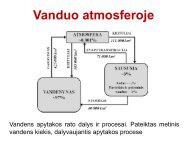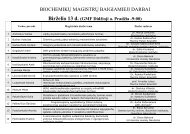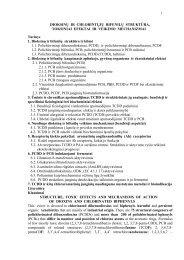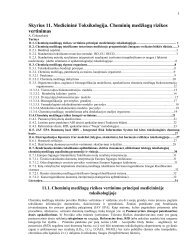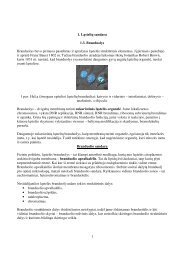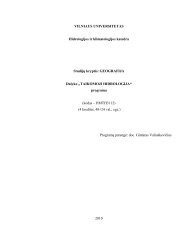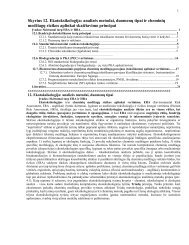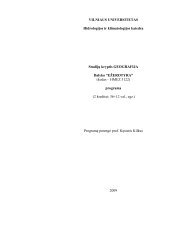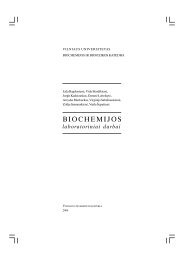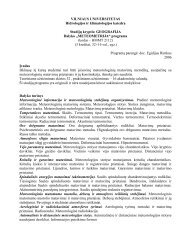Species and Their Formation - Laboratory of Visual Systems
Species and Their Formation - Laboratory of Visual Systems
Species and Their Formation - Laboratory of Visual Systems
Create successful ePaper yourself
Turn your PDF publications into a flip-book with our unique Google optimized e-Paper software.
(a)SPECIES AND THEIR FORMATION 483(b)Agelaius phoeniceus (male, NY) Agelaius phoeniceus (male, CA) Agelaius phoeniceus (female)24.2 Members <strong>of</strong> the Same <strong>Species</strong> Look Alike—or Not (a) Both<strong>of</strong> these male red-winged blackbirds are obviously members <strong>of</strong> thesame species, even though one is from the eastern United States <strong>and</strong>the other is from California. (b) Because red-winged blackbirds aresexually dimorphic (see Chapter 23), the female <strong>of</strong> the speciesappears quite different from the male.productively incompatible. Alternatively, they may becomereproductively incompatible before they evolve any noticeablemorphological differences. But how do these differencesbetween populations come about?How Do New <strong>Species</strong> Arise?Speciation is the process by which one species splitsinto two or more daughter species, which thereafter evolveas distinct lineages. Although Charles Darwin titled his bookThe Origin <strong>of</strong> <strong>Species</strong>, he did not extensively discuss speciation,a process he called “the mystery <strong>of</strong> mysteries.” He devotedmost <strong>of</strong> his attention to demonstrating that species areIncreasingGenetic distanceIncreasing01 A barrier isestablished.Interbreedingpopulation(parent species)2 The two populationsdiverge genetically butare still reproductivelycompatible.TimeDaughterspecies AReproductiveincompatibilityis established.Daughterspecies B24.3 Speciation May Be a Gradual Process In this hypotheticalexample, genetic divergence between two separated populationsbegins before reproductive incompatibility evolves.3altered by natural selection over time. But not all evolutionarychanges result in new species: A single lineage maychange over time without giving rise to a new species.The critical event in speciation is the separation <strong>of</strong> the genepool <strong>of</strong> the ancestral species into two or more separate <strong>and</strong>isolated gene pools. Subsequently, within each isolated genepool, allele <strong>and</strong> genotype frequencies may change as a result<strong>of</strong> the action <strong>of</strong> evolutionary agents. If two populations areisolated from each other, <strong>and</strong> sufficient differences in theirgenetic structure accumulate during the period <strong>of</strong> isolation,then the two populations may not be able to exchange geneswhen they come together again. As we will see, the amount<strong>of</strong> genetic difference that is needed to prevent gene exchangeis highly variable. Gene flow among populations may be interruptedin two major ways, each <strong>of</strong> which characterizes amode <strong>of</strong> speciation.Allopatric speciation requires total genetic isolationSpeciation that results when a population is divided by aphysical barrier is known as allopatric (allo-, “different”; patris,“country”) or geographic speciation (Figure 24.4). Allopatricspeciation is thought to be the dominant mode <strong>of</strong>speciation among most groups <strong>of</strong> organisms. The physicalbarrier that divides the range <strong>of</strong> a species may be a waterbody for terrestrial organisms, dry l<strong>and</strong> for aquatic organisms,or a mountain range. Barriers can form when continentsdrift, sea levels rise, glaciers advance <strong>and</strong> retreat, <strong>and</strong>climates change. These processes continue to generate physicalbarriers today. The populations separated by such barriersare <strong>of</strong>ten large initially. They evolve differences for a variety<strong>of</strong> reasons, especially because the environments inwhich they live are, or become, different.Allopatric speciation may also result when some members<strong>of</strong> a population cross an existing barrier <strong>and</strong> found a new, isolatedpopulation. Populations established in this way usuallydiffer genetically from their parent populations because <strong>of</strong>the founder effect: A small group <strong>of</strong> founding individuals has
484 CHAPTER TWENTY-FOURTimeA single species is distributedover a broad range.Sea level rises <strong>and</strong> separates two populations.Populations adapt to differing environmentson opposite sides <strong>of</strong> the barrier.If the barrier is removed, the populationsmay recolonize the intervening area <strong>and</strong>mingle, but do not interbreed.Another example <strong>of</strong> allopatric speciation is found in thefinches <strong>of</strong> the Galápagos archipelago, 1,000 km <strong>of</strong>f thecoast <strong>of</strong> Ecuador. Darwin’s finches (as they are usuallycalled, because Darwin was the first scientist to studythem) arose in the Galápagos by speciation from a singleSouth American species that colonized the isl<strong>and</strong>s. Todaythere are 14 species <strong>of</strong> Darwin’s finches, all <strong>of</strong> which differstrikingly from their closest mainl<strong>and</strong> relative (Figure24.6). The isl<strong>and</strong>s <strong>of</strong> the Galápagos archipelago are sufficientlyisolated from one another that finches seldom dispersebetween them. Also, environmental conditions differamong the isl<strong>and</strong>s. Some are relatively flat <strong>and</strong> arid;others have forested mountain slopes. Populations <strong>of</strong>finches on different isl<strong>and</strong>s have differentiated enoughover millions <strong>of</strong> years that when occasional immigrants arrivefrom other isl<strong>and</strong>s, they either do not breed with theresidents, or, if they do, the resulting <strong>of</strong>fspring usually donot survive as well as those produced by pairs composed<strong>of</strong> isl<strong>and</strong> residents. The genetic distinctness <strong>and</strong> cohesiveness<strong>of</strong> the different species is thus maintained.A physical barrier’s effectiveness at preventing geneflow depends on the size <strong>and</strong> mobility <strong>of</strong> the species inquestion. What is an impenetrable barrier to a terrestrialsnail may be no barrier at all to a butterfly or a bird. Popu-Range <strong>of</strong> overlapNumbers on the isl<strong>and</strong>s representthe number <strong>of</strong> species <strong>of</strong> picturewingedDrosophila found there.Picture-wingedDrosophila24.4 Allopatric Speciation Allopatric speciation may result whena population is divided into two separate populations by a physicalbarrier, such as rising sea levels.only an incomplete representation <strong>of</strong> the gene pool <strong>of</strong> its parentpopulation (see Chapter 23). For example, many <strong>of</strong> themore than 800 species <strong>of</strong> the fruit fly genus Drosophila in theHawaiian Isl<strong>and</strong>s are restricted to a single isl<strong>and</strong>. Thesespecies are almost certainly the descendants <strong>of</strong> new populationsfounded by individuals dispersing among the isl<strong>and</strong>s,because the closest relative <strong>of</strong> a species on one isl<strong>and</strong> is <strong>of</strong>tena species on a neighboring isl<strong>and</strong> rather than a species on thesame isl<strong>and</strong>. Biologists who have studied the chromosomes<strong>of</strong> picture-winged species <strong>of</strong> Drosophila believe that speciationamong this group <strong>of</strong> flies has resulted from at least 45such founder events (Figure 24.5).12Oldestisl<strong>and</strong>Kauai1Oahu29Numbers on the arrows representthe number <strong>of</strong> proposedfounder events. The arrowwidths are proportional tothese numbers.51210<strong>Species</strong> dispersal is primarilyfrom older to younger isl<strong>and</strong>s.73Mauicomplex4015126Youngestisl<strong>and</strong>Hawaii24.5 Founder Events Lead to Allopatric Speciation Thelarge number <strong>of</strong> species <strong>of</strong> picture-winged Drosophila in theHawaiian Isl<strong>and</strong>s is the result <strong>of</strong> founder events: new populationsfounded by individuals dispersing among the isl<strong>and</strong>s.The isl<strong>and</strong>s, which were formed in sequence as Earth’s crust movedover a volcanic “hot spot,” vary in age.
PacificOceanNorth AmericaSeed eatersBills <strong>of</strong> seed eaters areadapted for harvesting<strong>and</strong> crushing seeds.Large ground finch(Geospiza magnirostris)Medium ground finch(G. fortis)SPECIES AND THEIR FORMATION 485Large-billed finchescan crush large,hard seeds.Cocos Isl<strong>and</strong>GalápagosIsl<strong>and</strong>sSouthAmericaSmall ground finch(G. fuliginosa)Sharp-billed ground finch(G. difficilis)Small-billed finchescannot crush largeseeds as well, butare more adept ath<strong>and</strong>ling small seeds.Large cactus finch(G. conirostris)Cactus finches areadapted to openingcactus fruits <strong>and</strong>extracting the seeds.Cactus finch(G. sc<strong>and</strong>ens)Bud eater The bud eater‘s heavy bill is adaptedfor grasping <strong>and</strong> wrenching buds from branches.Vegetarian finch(Platyspiza crassirostris)Small tree finch(Camarhynchus parvulus)The large tree finchuses its heavy bill totwist apart wood toreach larvae inside.ANCESTOR FINCHfrom South Americanmainl<strong>and</strong>Large tree finch(C. psittacula)Medium tree finch(C. pauper)The small <strong>and</strong>medium tree finches<strong>and</strong> mangrove finchpick insects fromleaves <strong>and</strong> branches<strong>and</strong> explore crevicesfor hidden prey.Insect eatersThe bills <strong>of</strong> insect eaters varybecause they eat different types<strong>and</strong> sizes <strong>of</strong> insects <strong>and</strong> theycapture them in different ways.Mangrove finch(C. heliobates)Woodpecker finch(C. pallidus)Warbler finch(Certhidea olivacea)The woopecker finchuses its long beak toprobe dead wood,crevices, <strong>and</strong> barkfor insects.The warbler finchuses quick motions tocapture insects onplant surfaces.24.6 Allopatric Speciation among Darwin’s Finches The descendants<strong>of</strong> the ancestral finch that colonized the Galápagos archipelagoseveral million years ago evolved into 14 different species whosemembers are variously adapted to feed on seeds, buds, <strong>and</strong> insects.(The fourteenth species, not pictured here, lives in Cocos Isl<strong>and</strong>, farthernorth in the Pacific Ocean.)
486 CHAPTER TWENTY-FOURlations <strong>of</strong> wind-pollinated plants are isolated at the maximumdistance pollen can be blown by the wind, but individualplants are effectively isolated at much shorter distances.Among animal-pollinated plants, the width <strong>of</strong> the barrier isthe distance that animals can travel while carrying pollen orseeds. Even animals with great powers <strong>of</strong> dispersal are <strong>of</strong>tenreluctant to cross narrow strips <strong>of</strong> unsuitable habitat. For animalsthat cannot swim or fly, narrow water-filled gaps maybe effective barriers. However, gene flow can sometimes beinterrupted even in the absence <strong>of</strong> physical barriers.MeiosisHaploid gametes(one copy <strong>of</strong> eachchromosome)Sympatric speciation occurs without physical barriersAlthough physical isolation is usually required for speciation,under some circumstances speciation can occur withoutit. Such a partition <strong>of</strong> a gene pool is called sympatric speciation(sym-, “with”). The most common means <strong>of</strong> sympatricspeciation is polyploidy, the production within an individual<strong>of</strong> duplicate sets <strong>of</strong> chromosomes. Polyploidy can ariseeither from chromosome duplication in a single species(autopolyploidy) or from the combining <strong>of</strong> the chromosomes<strong>of</strong> two different species (allopolyploidy).An autopolyploid individual originates when (for example)cells that are normally diploid (with two sets <strong>of</strong> chromosomes)accidentally duplicate their chromosomes, resultingin a tetraploid (four sets <strong>of</strong> chromosomes) individual.Tetraploid <strong>and</strong> diploid plants <strong>of</strong> the same species are reproductivelyisolated because their triploid <strong>of</strong>fspring are essentiallysterile.Even if triploid individuals survive to reproductive maturity,they cannot produce viable gametes because theirchromosomes do not synapse correctly during meiosis (Figure24.7). So a tetraploid plant cannot produce viable <strong>of</strong>f-The diploidparent has twocopies <strong>of</strong> eachchromosomeMatingMeiosisMost gametes producedby the triploid hybridare not viable becausethey have an incorrectnumber <strong>of</strong> chromosomes.The F 1 <strong>of</strong>fspring istriploid (three copies<strong>of</strong> each chromosome)MeiosisDiploid gametes(two copies <strong>of</strong>each chromosome)The tetraploidparent has fourcopies <strong>of</strong> eachchromosome.24.7 Tetraploids Are Soon Reproductively Isolated from DiploidsEven if the triploid <strong>of</strong>fspring <strong>of</strong> diploid <strong>and</strong> tetraploid parents reachessexual maturity, most <strong>of</strong> the gametes it produces have inviable numbers<strong>of</strong> chromosomes. Such triploid individuals are effectively sterile.(For simplicity, the diagram shows only three chromosomes; mostspecies have many more than that.)
SPECIES AND THEIR FORMATION 487spring by mating with a diploid individual—but it can do soif it self-fertilizes or mates with another tetraploid.Allopolyploids may be produced when individuals <strong>of</strong> twodifferent (but closely related) species interbreed, or hybridize.Allopolyploids are usually fertile because each <strong>of</strong> thechromosomes has a nearly identical partner with which topair during meiosis.New species arise by means <strong>of</strong> polyploidy much more easilyamong plants than among animals because plants <strong>of</strong>many species can reproduce by self-fertilization. In addition,if polyploidy arises in several <strong>of</strong>fspring <strong>of</strong> a single parent, thesiblings can fertilize one another. Speciation by polyploidyhas been very important in the evolution <strong>of</strong> flowering plants.Botanists estimate that about 70 percent <strong>of</strong> flowering plantspecies <strong>and</strong> 95 percent <strong>of</strong> fern species are polyploids. Most <strong>of</strong>these arose as a result <strong>of</strong> hybridization between two species,followed by self-fertilization.How easily allopolyploidy can produce new species is illustratedby the salsifies (Tragopogon), members <strong>of</strong> the sunflowerfamily. Salsifies are weedy plants that thrive in disturbedareas around towns. People have inadvertentlyspread them around the world from their ancestral ranges inEurasia. Three diploid species <strong>of</strong> salsify were introduced intoNorth America early in the twentieth century: T. porrifolius,T. pratensis, <strong>and</strong> T. dubius. Two tetraploid hybrids—T. mirus<strong>and</strong> T. miscellus—between the original three diploid specieswere first discovered in 1950. The hybrids have spread sincetheir discovery <strong>and</strong> today are more widespread than theirdiploid parents (Figure 24.8).Studies <strong>of</strong> their genetic material have shown that both salsifyhybrids have formed more than once. Some populations<strong>of</strong> T. miscellus—a hybrid <strong>of</strong> T. pratensis <strong>and</strong> T. dubius— havethe chloroplast genome <strong>of</strong> T. pratensis; other populations havethe chloroplast genome <strong>of</strong> T. dubius. Such differences amonglocal populations <strong>of</strong> T. miscellus show that this allopolyploidhas formed independently at least 21 times! Scientists seldomknow the dates <strong>and</strong> locations <strong>of</strong> species formation so well. T.mirus, a hybrid <strong>of</strong> T. porrifolius <strong>and</strong> T. dubius, has formed 12times. T. porrifolius prefers wet, shady places; T. dubius prefersdry, sunny places. T. mirus, however, can grow in partlyshaded environments where neither parent does well. Thesuccess <strong>of</strong> these newly formed hybrid species <strong>of</strong> salsifies illustrateswhy so many species <strong>of</strong> flowering plants originatedas polyploids.Polyploidy, as we have just seen, can result in a newspecies that is completely reproductively isolated from its parentspecies in one generation. Allopatric speciation proceedsmuch more slowly, <strong>and</strong> some populations separated by aphysical barrier may never acquire full reproductive isolation.Let’s see how reproductive isolation may become establishedonce two populations have been separated from each other.A tetraploid hybrid has an almostcontinuous range in an areaaround Spokane, Washington.The range <strong>of</strong>tetraploid hybrids ( )is broader than that <strong>of</strong>diploid parentalspecies ( ).24.8 Polyploids May Outperform <strong>Their</strong> Parent <strong>Species</strong>Tragopogon species (salsifies) are members <strong>of</strong> the sunflower family.The map shows the distribution <strong>of</strong> the three diploid parent species<strong>and</strong> <strong>of</strong> the two tetraploid hybrid species <strong>of</strong> Tragopogon in easternWashington <strong>and</strong> adjacent Idaho.Completing Speciation:Reproductive Isolating MechanismsOnce a barrier to gene flow is established, by whatevermeans, the separated populations may diverge geneticallythrough the action <strong>of</strong> the evolutionary agents we describedin Chapter 23. Over many generations, differences may accumulatethat reduce the probability that members <strong>of</strong> the twopopulations could mate <strong>and</strong> produce viable <strong>of</strong>fspring. In thisway, reproductive isolation can evolve as an incidental byproduct<strong>of</strong> genetic changes in allopatric populations.Geographic isolation does not necessarily lead to reproductiveincompatibility. For example, American sycamores<strong>and</strong> European sycamores (also known as plane trees) havebeen physically isolated from one another for at least 20million years. Nevertheless, they are morphologically verysimilar (Figure 24.9), <strong>and</strong> they can form fertile hybrids,even though they never have an opportunity to do so innature.In other cases, however, genes that result in reproductiveisolation between two evolving lineages spreadquickly through populations as they diverge. In this section,we will examine the ways in which reproductive isolatingmechanisms may arise. In the following section, wewill explore what happens when reproductive isolation isincomplete.
488 CHAPTER TWENTY-FOUR24.9 Geographically Separated,Morphologically Similar Althoughthey have been separated by theAtlantic Ocean for at least 20 millionyears, American <strong>and</strong> Europeansycamores have diverged very little inappearance.(a) Platanus occidentalis (American sycamore)(b) Platanus hispanica (European sycamore)Prezygotic barriers operate before fertilizationSeveral processes that operate before fertilization—prezygoticreproductive barriers—may prevent individuals <strong>of</strong> differentspecies from interbreeding:Spatial isolation. Individuals <strong>of</strong> different species mayselect different places in the environment in which to live.As a result, they may never come into contact duringtheir respective mating periods; that is, they are reproductivelyisolated by location.Temporal isolation. Many organisms have mating periodsthat are as short as a few hours or days. If the matingperiods <strong>of</strong> two species do not overlap, they will be reproductivelyisolated by time.Mechanical isolation. Differences in the sizes <strong>and</strong> shapes <strong>of</strong>reproductive organs may prevent the union <strong>of</strong> gametesfrom different species.Gametic isolation. Sperm <strong>of</strong> one species may not attach tothe eggs <strong>of</strong> another species because the eggs do notrelease the appropriate attractive chemicals, or the spermmay be unable to penetrate the egg because the twogametes are chemically incompatible.Behavioral isolation. Individuals <strong>of</strong> a species may reject, orfail to recognize, individuals <strong>of</strong> other species as matingpartners.Two closely related species <strong>of</strong> crickets from the isl<strong>and</strong> <strong>of</strong>Hawaii, Laupala paranga <strong>and</strong> Laupala kohalensis, provide an example<strong>of</strong> behavioral isolation. These two species live in separateareas <strong>and</strong> do not hybridize in nature, but they will forminterspecific pairs in the laboratory. The males <strong>of</strong> the twospecies produce genetically determined songs that differ inthe number <strong>of</strong> pulses per second. The songs <strong>of</strong> hybrid maleshave intermediate numbers <strong>of</strong> pulses (Figure 24.10). Femalesare much more strongly attracted to the songs <strong>of</strong> conspecificmales (males <strong>of</strong> their own species) than they are to the songs<strong>of</strong> males <strong>of</strong> the other species. We know that this preference isgenetically determined because hybrid females are moststrongly attracted to the songs <strong>of</strong> hybrid males.Sometimes the mate choice <strong>of</strong> one species is mediated bythe behavior <strong>of</strong> individuals <strong>of</strong> other species. For example,whether two plant species hybridize may depend on thepreferences <strong>of</strong> their pollinators. Because pollinators visit flowersto gather nutritional rewards, not to pollinate plants, pollinatorbehavior can be influenced only by changes in floralstructures that affect the rewards the pollinators receive. Floraltraits can affect reproductive isolation either by influencingpollinator behavior or by altering where pollen is depositedon the bodies <strong>of</strong> pollinators.The evolution <strong>of</strong> floral traits that generate reproductiveisolation has been studied in columbines <strong>of</strong> the genus Aquilegia.Columbines have undergone recent <strong>and</strong> very rapid spe-Number <strong>of</strong> individuals producing songswith that pulse frequency5040302010LaupalaparanigraF 1 hybrid generationPulse frequency <strong>of</strong>hybrid male songsdoes not overlapfrequencies <strong>of</strong> songs<strong>of</strong> parental males.Laupalakohalensis0 1.0 2.0 3.0 4.0 5.0Pulses per secondNarrow range <strong>of</strong>pulse frequenciesindicates strongstabilizing selection.24.10 Songs <strong>of</strong> Male Crickets are Genetically DeterminedHybrid males produce songs with intermediate pulse frequencies.
SPECIES AND THEIR FORMATION 489ciation <strong>and</strong>, at the same time, have evolved long floral nectarspurs—tubular outgrowths <strong>of</strong> petals that produce nectarat their tips. Animals pollinate these flowers while probingthe spurs to collect nectar. The length <strong>of</strong> the spurs <strong>and</strong> the orientation<strong>of</strong> the flowers influence how efficiently pollinatorscan extract nectar. Two species, Aquilegia formosa <strong>and</strong> Aquilegiapubescens, that grow in the mountains <strong>of</strong> California canproduce fertile hybrids. A. formosa has pendant (hanging)flowers <strong>and</strong> short spurs (Figure 24.11a); it is pollinated byhummingbirds. A. pubescens has upright flowers <strong>and</strong> longspurs (Figure 24.11b); it is pollinated by hawkmoths.Investigators tested discrimination among these flowersby hawkmoths by turning A. formosa flowers so that theywere upright. Hawkmoths still visited mostly A. pubescensflowers (Figure 24.11c), probably because the flowers <strong>of</strong> thetwo species differ strongly in the color <strong>of</strong> light they reflect.Genetic analyses <strong>of</strong> hybrids between the two species showthat the color differences are caused by a small number <strong>of</strong>genes. Thus, although these two species are interfertile, hybridsrarely form in nature because the two species attractdifferent pollinators.Postzygotic barriers operate after fertilizationIf individuals <strong>of</strong> two different populations overcome prezygoticreproductive barriers <strong>and</strong> interbreed, postzygotic reproductivebarriers may still prevent gene exchange. Geneticdifferences that accumulated while the populations were isolatedfrom each other may reduce the survival <strong>and</strong> reproduction<strong>of</strong> the hybrid <strong>of</strong>fspring in any <strong>of</strong> several ways:Hybrid zygote abnormality. Hybrid zygotes may fail tomature normally, either dying during development ordeveloping such severe abnormalities that they cannotmate as adults.Hybrid infertility. Hybrids may mature normally, but beinfertile when they attempt to reproduce. For example,the <strong>of</strong>fspring <strong>of</strong> matings between horses <strong>and</strong> donkeys—mules—are strong, but sterile; they produce no descendants.Low hybrid viability. Hybrid <strong>of</strong>fspring may simply surviveless well than <strong>of</strong>fspring resulting from matingswithin populations.(a) Aquilegia formosa(c)Number <strong>of</strong> visits by hawkmoths140120100806040200A. pubescens(normalorientation)(b) Aquilegia pubescensA. formosa(upright)A. formosa(normalorientation)24.11 Hawkmoths Favor Flowers <strong>of</strong> One Columbine <strong>Species</strong>Flowers <strong>of</strong> Aquilegia formosa are normally pendant (a), while those <strong>of</strong>A. pubescens are normally upright (b). The plants can interbreed, butthe hawkmoths that pollinate A. pubescens distinguish between flowers<strong>of</strong> the two species, even when A. formosa flowers are experimentallymodified to be upright (c).If hybrid <strong>of</strong>fspring survive poorly, more effective prezygoticbarriers may evolve, because individuals that mate with individuals<strong>of</strong> the other population will leave fewer surviving <strong>of</strong>fspringthan individuals that mate only within their own population.This strengthening <strong>of</strong> prezygotic barriers is known asreinforcement. Reinforcement is difficult to detect experimentally,but it can be detected by using the comparativemethod (see Chapter 1). If reinforcement is occurring, thensympatric pairs <strong>of</strong> species should evolve prezygotic reproductivebarriers more rapidly than allopatric pairs <strong>of</strong> speciesdo. In a study <strong>of</strong> related sympatric <strong>and</strong> allopatric species <strong>of</strong>Drosophila, this was shown to be the case (Figure 24.12).We can observe speciation in progressSince speciation is a gradual process, we can find many examples<strong>of</strong> populations at different stages on the way to completereproductive isolation. A good example <strong>of</strong> speciation inprogress is found in a picture-winged fruit fly (Rhagoletispomenella) in New York State. Until the mid-1800s, these fruitflies courted, mated, <strong>and</strong> deposited their eggs only onhawthorn fruits. The larvae recognized the odor <strong>of</strong> hawthorn
490 CHAPTER TWENTY-FOURCOMPARATIVE METHODHypothesis: If reinforcement has occurred, sympatric species <strong>of</strong>Drosophila should be more strongly isolated prezygotically thanallopatric species that have been separated for equal amounts <strong>of</strong> time.METHODRESULTSStrongPrezygotic isolationWeakLowAssess length <strong>of</strong> time Drosophila populations have beenevolving separately by the amount <strong>of</strong> genetic distancebetween them. Compare strength <strong>of</strong> prezygoticisolation between allopatric <strong>and</strong> sympatric speciespairs.Recently diverged pairs <strong>of</strong> sympatric species havemore prezygotic isolation than allopatric species do.Genetic distanceAllopatric species pairsSympatric species pairsGenetic distance, a measure <strong>of</strong> moleculargenetic differences between the species ina pair, is an indication <strong>of</strong> the length <strong>of</strong> timethe species have been evolving separately.HighConclusion: Reinforcement has resulted in particularly rapidevolution <strong>of</strong> prezygotic isolation among recently diverged sympatricspecies <strong>of</strong> Drosophila.24.12 Prezygotic Barriers Can Evolve Rapidly Reinforcement mayoccur when individuals who mate outside their own population leavefew or no viable <strong>of</strong>fspring. In such a situation, prezygotic isolatingmechanisms can evolve extremely rapidly.as they fed on the fruits, <strong>and</strong> when they emerged from theirpupae, they used this cue to locate other hawthorn plants onwhich to mate <strong>and</strong> lay their eggs.About 150 years ago, large commercial apple orchardswere planted in the Hudson River valley. Apple trees areclosely related to hawthorns, <strong>and</strong> a few female Rhagoletis laidtheir eggs on apples, perhaps by mistake. <strong>Their</strong> larvae didnot grow as well as the larvae on hawthorn fruits, but manydid survive. These larvae recognized the odor <strong>of</strong> apples, sowhen they emerged as adults, they sought out apple trees,where they mated with other flies reared on apples.Today there are two types <strong>of</strong> Rhagoletis in the HudsonRiver valley that may be on the way to becoming distinctspecies. One feeds primarily on hawthorn fruits, the other onapples. The two incipient species are partly reproductivelyisolated because they mate primarily with individuals raisedon the same fruit <strong>and</strong> because they emerge from their pupaeat different times <strong>of</strong> the year. In addition, the apple-feedingflies have evolved so that they now grow more rapidly onapples than they originally did.Reproductive isolation does not develop at the same ratein all diverging populations. On the one h<strong>and</strong>, in somegroups, such as Darwin’s finches, there has been conspicuousmorphological evolution, but many <strong>of</strong> the 14 species stillinterbreed <strong>and</strong> produce fertile hybrid <strong>of</strong>fspring. On the otherh<strong>and</strong>, reproductive isolation may develop rapidly, as it hasbetween diverging sympatric species <strong>of</strong> Drosophila. Generally,reproductive isolation evolves more rapidly in speciesthat have rapid reproductive rates (for example, most plants,fruit flies, <strong>and</strong> sea urchins) than in species that have slowerreproductive rates (for example, birds <strong>and</strong> mammals).Many species in nature form hybrids in areas where theirranges overlap, <strong>and</strong> they may continue to do so for manyyears. Let’s examine what happens in these situations.Hybrid Zones:Incomplete Reproductive IsolationIf contact is reestablished between formerly isolated populationsbefore complete reproductive isolation has developed,members <strong>of</strong> the two populations may interbreed. Three outcomes<strong>of</strong> such interbreeding are possible:If hybrid <strong>of</strong>fspring are as successful as those resultingfrom matings within each population, hybrids mayspread through both populations <strong>and</strong> reproduce withother individuals. The gene pools would then combine,<strong>and</strong> no new species would result from the period <strong>of</strong> isolation.If hybrid <strong>of</strong>fspring are less successful, complete reproductiveisolation may evolve as reinforcement strengthensprezygotic reproductive barriers.Even if hybrid <strong>of</strong>fspring are at some disadvantage, a narrowhybrid zone may persist if, for one or more reasons,reinforcement does not happen.Hybrid zones are excellent natural laboratories for thestudy <strong>of</strong> speciation. When a hybrid zone first forms, most hybridsare <strong>of</strong>fspring <strong>of</strong> crosses between purebred individuals<strong>of</strong> the two species. However, subsequent generations includea variety <strong>of</strong> individuals with different proportions <strong>of</strong> theirgenes derived from the original two populations. Thus, hybridzones contain recombinant individuals resulting frommany generations <strong>of</strong> hybridization. Detailed genetic studiescan tell us much about why hybrid zones may be narrow <strong>and</strong>stable for long periods <strong>of</strong> time.European toads <strong>of</strong> the genus Bombina have been the subject<strong>of</strong> such studies. The fire-bellied toad (B. bombina) lives ineastern Europe. The closely related yellow-bellied toad (B.variegata) lives in western <strong>and</strong> southern Europe. The ranges<strong>of</strong> the two species meet in a narrow zone stretching 4,800 km
SPECIES AND THEIR FORMATION 491(a) Bombina bombina(b) Bombina variegata(c)B. bombina(fire-belliedtoad)24.13 Hybrid Zones May Be Long <strong>and</strong> Narrow Thenarrow zone in Europe where fire-bellied toads (a) meet<strong>and</strong> hybridize with yellow-bellied toads (b) stretchesacross Europe (c). This hybrid zone has been stable forhundreds <strong>of</strong> years, but has never exp<strong>and</strong>ed becausehybrid toads are much less fit than individuals <strong>of</strong> theparental species.B. variegata(yellow-belliedtoad)Area <strong>of</strong>overlapfrom eastern Germany to the Black Sea (Figure 24.13). Hybridsbetween the two species suffer from a range <strong>of</strong> defects,many <strong>of</strong> which are lethal. Those that survive <strong>of</strong>ten haveskeletal abnormalities, such as misshapen mouths, ribs thatare fused to vertebrae, <strong>and</strong> a reduced number <strong>of</strong> vertebrae.By following the fates <strong>of</strong> thous<strong>and</strong>s <strong>of</strong> toads from the hybridzone, investigators have found that a hybrid toad is halfas fit as a purebred individual. The hybrid zone is narrow becausethere is strong selection against hybrids, <strong>and</strong> becauseadult toads do not move over long distances. It has persistedfor hundreds <strong>of</strong> years because individuals that move into ithave not previously encountered individuals <strong>of</strong> the otherspecies, so there has been no opportunity for reinforcementto occur.If two species hybridize, we know that they must be similargenetically, but the absence <strong>of</strong> interbreeding tells us nothingabout how dissimilar two species are. Not until modernmolecular genetic techniques were developed could biologistsmeasure genetic differences among species. These techniquesshow that the genetic differences that separate speciesare primarily differences among genes involved with reproductiveisolation. The extensive data gathered on Drosophilaindicate that fewer than ten, <strong>and</strong> <strong>of</strong>ten fewer than five, genesare responsible for reproductive isolation. Individuals <strong>of</strong> differentspecies <strong>of</strong> Hawaiian Drosophila share nearly all <strong>of</strong> theirmitochondrial DNA alleles. All <strong>of</strong> the hundreds <strong>of</strong> species <strong>of</strong>Drosophila that have evolved in the Hawaiian Isl<strong>and</strong>s duringthe past 32 million years, even those that have diverged morphologically,are relatively similar genetically (Figure 24.14).Drosophila silvestrisDrosophila baliopteraDrosophila conspicua24.14 Morphologically Different, Genetically Similar Althoughthese fruit flies—a small sample <strong>of</strong> the hundreds <strong>of</strong> species foundonly on the Hawaiian Isl<strong>and</strong>s—vary greatly in appearance, they aregenetically similar.
492 CHAPTER TWENTY-FOURVariation in Speciation RatesSome lineages <strong>of</strong> organisms have many species; others haveonly a few. Hundreds <strong>of</strong> species <strong>of</strong> Drosophila evolved in theHawaiian Isl<strong>and</strong>s, but there is only one species <strong>of</strong> horseshoecrab, even though its lineage has survived for more than 300million years. Why do rates <strong>of</strong> speciation vary so widelyamong lineages?A number <strong>of</strong> factors are known to influence speciationrates:<strong>Species</strong> richness. The larger the number <strong>of</strong> species in a lineage,the larger the number <strong>of</strong> opportunities for newspecies to form. For speciation by polyploidy, the morespecies in a lineage, the more species are available tohybridize with one another. For allopatric speciation, thelarger the number <strong>of</strong> species living in an area, the largerthe number <strong>of</strong> species whose ranges will be bisected bya given physical barrier.Dispersal rates. Individuals <strong>of</strong> species with poor dispersalabilities are unlikely to establish new populations by dispersingacross barriers. Even narrow barriers are effectivein dividing species whose members are highlysedentary.Ecological specialization. Populations <strong>of</strong> species restrictedto habitat types that are patchy in distribution are morelikely to diverge than are populations that occupy relativelycontinuous habitats.Population bottlenecks. The changes in gene pools that<strong>of</strong>ten occur when a population passes through a bottleneckmay result in new adaptations.Type <strong>of</strong> pollination. Speciation rates in plants are correlatedwith pollination mode. Animal-pollinated plant familieshave, on average, 2.4 times as many species as closelyrelated families pollinated by wind. In addition, theswitch from animal to wind pollination is strongly associatedwith a reduction in the rate <strong>of</strong> speciation in a lineage.Sexual selection. Animals with complex behavior are likelyto form new species at a high rate because they makesophisticated discriminations among potential matingpartners. They distinguish members <strong>of</strong> their own speciesfrom members <strong>of</strong> other species, <strong>and</strong> they make subtlediscriminations among members <strong>of</strong> their own species onthe basis <strong>of</strong> size, shape, appearance, <strong>and</strong> behavior (seeFigures 23.16 <strong>and</strong> 23.17). Such discriminations can greatlyinfluence which individuals are most successful inproducing <strong>of</strong>fspring <strong>and</strong> may lead to rapid reinforcement<strong>of</strong> reproductive isolation between species.Environmental changes. Oscillations <strong>of</strong> climates may fragmentpopulations <strong>of</strong> species that live in formerly continuoushabitats.Number <strong>of</strong> new antelope speciesappearing in the fossil record201510504 3 2 1Millions <strong>of</strong> years agoAfrican antelopes provide a striking example <strong>of</strong> the influence<strong>of</strong> climate change on speciation rates. These animals experienceda burst <strong>of</strong> speciation <strong>and</strong> extinction between 2.5<strong>and</strong> 2.9 mya. During that period, the number <strong>of</strong> known antelopespecies doubled, <strong>and</strong> 90 percent <strong>of</strong> all known specieseither first appeared or became extinct (Figure 24.15). Thisburst coincided with a shift in Africa from a warm, wet climateto one that oscillated between warm <strong>and</strong> wet <strong>and</strong> coolerbut drier conditions. During this period, grassl<strong>and</strong> <strong>and</strong> savannaenvironments increased <strong>and</strong> decreased, repeatedly coalescing<strong>and</strong> separating over much <strong>of</strong> Africa as the climateoscillated. The burst <strong>of</strong> speciation among antelopes resultedin many new species adapted to these environments.Evolutionary RadiationsMany new speciesappeared 2.5–2.9 mya.24.15 Climate Change Drove a Burst <strong>of</strong> Speciation amongAntelopes The excellent fossil record <strong>of</strong> African antelopes revealsthat there was a sudden burst <strong>of</strong> speciation between 2.5 <strong>and</strong> 2.9 millionyears ago. At that time, the climate <strong>of</strong> Africa shifted from beingconsistently warm <strong>and</strong> wet to oscillating between warm <strong>and</strong> wet <strong>and</strong>cool <strong>and</strong> dry.The fossil record reveals that, at certain times in certain lineages,speciation rates have been much higher than extinctionrates. The result is the proliferation <strong>of</strong> a large number <strong>of</strong>daughter species, as happened with finches in the Galápagosarchipelago (see Figure 24.6). Such an event is called an evolutionaryradiation. What conditions cause speciation ratesto be much higher than extinction rates?Evolutionary radiations are likely when a population colonizesa new environment that contains relatively fewspecies. As we saw in Chapter 22, evolutionary radiations occurredin many lineages on continents following mass extinctions.Evolutionary radiations occur on isl<strong>and</strong>s becauseisl<strong>and</strong>s lack many plant <strong>and</strong> animal groups found on themainl<strong>and</strong>. The ecological opportunities that exist on isl<strong>and</strong>smay stimulate rapid evolutionary changes when a newspecies does reach them. Water barriers also restrict geneflow among the isl<strong>and</strong>s in an archipelago, so populations on
SPECIES AND THEIR FORMATION 49324.16 Rapid Evolution among HawaiianSilverswords The Hawaiian silverswords, threeclosely related genera <strong>of</strong> the sunflower family, arebelieved to have descended from a single commonancestor, similar to the tarweed (Madia sativa), thatcolonized Hawaii from the Pacific coast <strong>of</strong> NorthAmerica. The four plants shown here are moreclosely related than they appear to be based ontheir morphology.Madia sativa (tarweed)Argyroxiphium s<strong>and</strong>wicenseDubautia menziesiiWilkesia hobdyidifferent isl<strong>and</strong>s may evolve adaptations to their local environments.Together, these two factors make it likely that speciationrates <strong>of</strong> newly colonizing lineages on isl<strong>and</strong> archipelagoeswill exceed extinction rates.Remarkable evolutionary radiations have occurred in theHawaiian Isl<strong>and</strong>s, the most isolated isl<strong>and</strong>s in the world. TheHawaiian Isl<strong>and</strong>s lie 4,000 km from the nearest major l<strong>and</strong>mass <strong>and</strong> 1,600 km from the nearest group <strong>of</strong> isl<strong>and</strong>s. The nativebiota <strong>of</strong> the Hawaiian Isl<strong>and</strong>s includes 1,000 species <strong>of</strong>flowering plants, 10,000 species <strong>of</strong> insects, 1,000 l<strong>and</strong> snails,<strong>and</strong> more than 100 bird species. However, there were no amphibians,no terrestrial reptiles, <strong>and</strong> only one native mammal—abat—on the isl<strong>and</strong>s until humans introduced additionalspecies. The 10,000 known native species <strong>of</strong> insects onHawaii are believed to have evolved from only about 400 immigrantspecies; only 7 immigrant species are believed to accountfor all the native Hawaiian l<strong>and</strong> birds.More than 90 percent <strong>of</strong> all plant species on the HawaiianIsl<strong>and</strong>s are endemic—that is, they are found nowhereelse. Several groups <strong>of</strong> flowering plants have more diverseforms <strong>and</strong> life histories on the isl<strong>and</strong>s, <strong>and</strong> live in a widervariety <strong>of</strong> habitats, than do their close relatives on themainl<strong>and</strong>. An outst<strong>and</strong>ing example is the group <strong>of</strong> Hawaiiansunflowers called silverswords (the genera Argyroxiphium,Dubautia, <strong>and</strong> Wilkesia). Chloroplast DNA sequencesshow that these species share a relatively recent commonancestor with a species <strong>of</strong> tarweed from the Pacific coast <strong>of</strong>North America (Figure 24.16). Whereas all mainl<strong>and</strong> tarweedsare small, upright, herbs (that is, nonwoody plants),the silverswords include prostrate <strong>and</strong> upright herbs,shrubs, trees, <strong>and</strong> vines. Silverword species occupy nearlyall the habitats <strong>of</strong> the Hawaiian isl<strong>and</strong>s, from sea level toabove timberline in the mountains. Despite their extraordinarymorphological diversification, however, the silver-
494 CHAPTER TWENTY-FOURswords have differentiated very little in their chloroplastgenes.The isl<strong>and</strong> silverswords are more diverse in size <strong>and</strong>shape than the mainl<strong>and</strong> tarweeds because the original colonizersarrived on isl<strong>and</strong>s that had very few plant species. Inparticular, there were few trees <strong>and</strong> shrubs, because suchlarge-seeded plants rarely disperse to oceanic isl<strong>and</strong>s. In fact,many isl<strong>and</strong> trees <strong>and</strong> shrubs have evolved from nonwoodyancestors. On the mainl<strong>and</strong>, however, tarweeds live in ecologicalcommunities that contain tree <strong>and</strong> shrub lineagesolder than their own—that is, where opportunities to exploitthe “tree” way <strong>of</strong> life have already been preempted.The processes we have discussed in this chapter, operatingover billions <strong>of</strong> years, have produced a world in which life isorganized into millions <strong>of</strong> species, each adapted to live in aparticular environment <strong>and</strong> to use environmental resourcesin a particular way. How these millions <strong>of</strong> species are distributedover the surface <strong>of</strong> Earth <strong>and</strong> organized into ecologicalcommunities will be a major focus <strong>of</strong> Part Eight <strong>of</strong> this book.Chapter SummaryWhat Are <strong>Species</strong>? <strong>Species</strong> are independent evolutionary units. A commonlyaccepted definition <strong>of</strong> species is “groups <strong>of</strong> actually or potentiallyinterbreeding natural populations which are reproductivelyisolated from other such groups.” Because speciation is <strong>of</strong>ten a gradual process, it may be difficultto recognize boundaries between species. Review Figure 24.3How Do New <strong>Species</strong> Arise? Not all evolutionary changes result in new species. Allopatric (geographic) speciation is the most importantmode <strong>of</strong> speciation among animals <strong>and</strong> is common in othergroups <strong>of</strong> organisms. Review Figures 24.4, 24.5, 24.6.See Web/CD Tutorial 24.2 Sympatric speciation may occur rapidly by polyploidybecause polyploid <strong>of</strong>fspring are sterile in crosses with members<strong>of</strong> the parent species. Polyploidy is a major factor in plant speciationbut is rare among animals. Review Figures 24.7, 24.8See Web/CD Tutorial 24.1Completing Speciation: Reproductive IsolatingMechanisms Once two populations have been separated, reproductive isolatingmechanisms may prevent the exchange <strong>of</strong> genes betweenthem. Prezygotic reproductive barriers operate before fertilization.Some prezygotic barriers affect mate choice; others work byinfluencing pollinator behavior. Review Figure 24.10, 24.11 Postzygotic reproductive barriers operate after fertilization byreducing the survival or fertility <strong>of</strong> hybrid <strong>of</strong>fspring. If hybrid <strong>of</strong>fspring survive poorly, more effective prezygoticreproductive barriers may evolve. This process is known asreinforcement. Review Figure 24.12Hybrid Zones: Incomplete Reproductive Isolation Hybrid zones may develop if barriers to gene exchange fail todevelop while diverging species are isolated from each other.Review Figure 24.13 <strong>Species</strong> may differ from one another in very few genes.Variation in Speciation Rates Rates <strong>of</strong> speciation differ greatly among lineages. Speciationrates are influenced by the number <strong>of</strong> species in a lineage, theirdispersal rates, ecological specialization, experience <strong>of</strong> populationbottlenecks, pollinators, <strong>and</strong> behavior, as well as by climaticchanges.Evolutionary Radiations Evolutionary radiations occur when speciation rates exceedextinction rates. High speciation rates <strong>of</strong>ten coincide with low extinction rateswhen species invade isl<strong>and</strong>s or other environments that containfew other species. As a result <strong>of</strong> speciation, Earth is populated with millions <strong>of</strong>species, each adapted to live in a particular environment <strong>and</strong> touse resources in a particular way.See Web/CD Activity 24.1 for a concept review <strong>of</strong> this chapter.Self-Quiz1. A species is a group <strong>of</strong>a. actually interbreeding natural populations that arereproductively isolated from other such groups.b. potentially interbreeding natural populations that arereproductively isolated from other such groups.c. actually or potentially interbreeding natural populationsthat are reproductively isolated from other such groups.d. actually or potentially interbreeding natural populationsthat are reproductively connected to other such groups.e. actually interbreeding natural populations that arereproductively connected to other such groups.2. Allopatric speciation may happen whena. continents drift apart <strong>and</strong> separate previously connectedlineages.b. a mountain range separates formerly connected populations.c. different environments on two sides <strong>of</strong> a barrier causepopulations to diverge.d. the range <strong>of</strong> a species is separated by loss <strong>of</strong> intermediatehabitat.e. all <strong>of</strong> the above3. Finches speciated in the Galápagos Isl<strong>and</strong>s becausea. the Galápagos Isl<strong>and</strong>s are not far from the mainl<strong>and</strong>.b. the Galápagos Isl<strong>and</strong>s are arid.c. the Galápagos Isl<strong>and</strong>s are small.d. the isl<strong>and</strong>s <strong>of</strong> the Galápagos Archipelago are sufficientlyisolated from one another that there is little migrationamong them.e. the isl<strong>and</strong>s <strong>of</strong> the Galápagos Archipelago are closeenough to one another that there is considerablemigration among them.4. Which <strong>of</strong> the following is not a potential prezygoticreproductive barrier?a. Temporal segregation <strong>of</strong> breeding seasonsb. Differences in chemicals that attract matesc. Hybrid infertilityd. Spatial segregation <strong>of</strong> mating sitese. Sperm cannot survive in female reproductive tracts
SPECIES AND THEIR FORMATION 4955. A common means <strong>of</strong> sympatric speciation isa. polyploidy.b. hybrid infertility.c. temporal segregation <strong>of</strong> breeding seasons.d. spatial segregation <strong>of</strong> mating sites.e. imposition <strong>of</strong> a geographic barrier.6. Sympatric species are <strong>of</strong>ten similar in appearance becausea. appearances are <strong>of</strong>ten <strong>of</strong> little evolutionary significance.b. the genetic changes accompanying speciation are <strong>of</strong>tensmall.c. the genetic changes accompanying speciation are usuallylarge.d. speciation usually requires major reorganization <strong>of</strong> thegenome.e. the traits that differ among species are not the same as thetraits that differ among individuals within species.7. Narrow hybrid zones may persist for long times becausea. hybrids are always at a disadvantage.b. hybrids have an advantage only in narrow zones.c. hybrid individuals never move far from their birthplaces.d. individuals that move into the zone have not previouslyencountered individuals <strong>of</strong> the other species, so reinforcement<strong>of</strong> isolating mechanisms has not occurred.e. Narrow hybrid zones are artifacts because biologistsgenerally restrict their studies to contact zones betweenspecies.8. Which statement about speciation is not true?a. It always takes thous<strong>and</strong>s <strong>of</strong> years.b. It <strong>of</strong>ten takes thous<strong>and</strong>s <strong>of</strong> years, but may happen withina single generation.c. Among animals, it usually requires a physical barrier.d. Among plants, it <strong>of</strong>ten happens as a result <strong>of</strong> polyploidy.e. It has produced the millions <strong>of</strong> species living today.9. Speciation is <strong>of</strong>ten rapid within lineages in which specieshave complex behavior becausea. individuals <strong>of</strong> such species make fine discriminationsamong potential mating partners.b. such species have short generation times.c. such species have high reproductive rates.d. such species have complex relationships with theirenvironments.e. none <strong>of</strong> the above10. Evolutionary radiationsa. <strong>of</strong>ten happen on continents, but rarely on isl<strong>and</strong>archipelagos.b. characterize birds <strong>and</strong> plants, but not other taxonomicgroups.c. have happened on continents as well as on isl<strong>and</strong>s.d. require major reorganizations <strong>of</strong> the genome.e. never happen in species-poor environments.11. Speciation is an important component <strong>of</strong> evolution becauseita. generates the variation upon which natural selection acts.b. generates the variation upon which genetic drift <strong>and</strong>mutations act.c. enabled Charles Darwin to perceive the mechanisms <strong>of</strong>evolution.d. generates the high extinction rates that drive evolutionarychange.e. has resulted in a world with millions <strong>of</strong> species, eachadapted for a particular way <strong>of</strong> life.For Discussion1. The snow goose <strong>of</strong> North America has two distinct colorforms: blue <strong>and</strong> white. Matings between the two color formsare common. However, blue individuals pair with blue individuals<strong>and</strong> white individuals pair with white individualsmuch more frequently than would be expected by chance.Suppose that 75 percent <strong>of</strong> all mated pairs consisted <strong>of</strong> twoindividuals <strong>of</strong> the same color. What would you concludeabout speciation processes in these geese? If 95 percent <strong>of</strong>pairs were the same color? If 100 percent <strong>of</strong> pairs were thesame color?2. Suppose pairs <strong>of</strong> snow geese <strong>of</strong> mixed colors were found onlyin a narrow zone within the broad Arctic breeding range <strong>of</strong>the geese. Would your answer to Question 1 remain thesame? Would your answer change if mixed-color pairs werewidely distributed across the breeding range <strong>of</strong> the geese?3. Although many butterfly species are divided into local populationsamong which there is little gene flow, these species<strong>of</strong>ten show relatively little morphological variation amongpopulations. Describe the studies you would conduct todetermine what maintains this morphological similarity.4. Evolutionary radiations are common <strong>and</strong> easily studied onoceanic isl<strong>and</strong>s, but in what types <strong>of</strong> mainl<strong>and</strong> situationswould you expect to find major evolutionary radiations?Why?5. Fruit flies <strong>of</strong> the genus Drosophila are distributed worldwide,but most <strong>of</strong> the species in the genus are found on theHawaiian Isl<strong>and</strong>s. What might account for this distributionpattern?6. Evolutionary radiations take place when speciation ratesexceed extinction rates. What factors can cause extinctionrates to exceed speciation rates in a lineage? Name some lineagesin which human activities are increasing extinction rateswithout increasing speciation rates.



